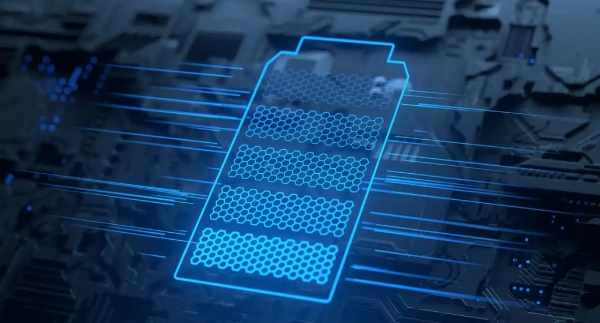Part 1. What is a ternary lithium battery?
A ternary lithium battery is a rechargeable lithium battery that uses three transition metal oxides of nickel, cobalt and manganese as the positive electrode material. It fully combines the good cycle performance of lithium cobalt oxide, the high specific capacity of lithium nickel oxide, and the high safety and low cost of lithium manganate. Synergistic composite lithium-embedded oxides of nickel, cobalt, manganese and other multi-elements are synthesized using methods such as molecular level mixing, doping, coating and surface modification. The ternary battery is a lithium-ion rechargeable battery currently widely researched and applied.
From the material point of view, the “ternary” of ternary lithium batteries refers to a polymer containing three metal elements: nickel, cobalt, manganese or aluminum, which is used as the positive electrode in ternary lithium batteries. All three are indispensable. Each element plays an important role, and the characteristics of each element also restrict battery performance.
Structurally, ternary lithium batteries have high energy density and charge and discharge efficiency. At the same time, it is not resistant to high temperatures. Therefore, poor safety and short cycle life are the main shortcomings of ternary lithium batteries. In particular, safety performance is a major factor that has always limited its large-scale configuration and integration applications. Many tests have shown that it is difficult for ternary batteries with larger capacities to pass safety tests such as acupuncture and overcharge. This is also why more manganese elements are generally introduced into large-capacity batteries or mixed with lithium manganate.

Part 2. Advantages and disadvantages of ternary lithium batteries
Ternary Lithium Battery Advantages
The ternary lithium battery is a battery with excellent comprehensive performance. The main functions, advantages and disadvantages of the three metal elements are as follows:
- Co3+: Reduce the mixed cation occupation, stabilize the layered structure of the material, reduce the impedance value, increase conductivity, and improve cycle and rate performance.
- Ni2+: can increase the material’s capacity (increase the material’s volumetric energy density). Due to the similar radii of Li and Ni, too much Ni will also cause the mixing of lithium and nickel due to dislocations with Li. The greater the concentration of nickel ions in the lithium layer, the more difficult it is for lithium to be deintercalated in the layered structure, resulting in poor electrochemical performance.
- Mn4+: Not only can it reduce material costs, but it can also improve the safety and stability of materials. However, suppose the Mn content is too high. In that case, the spinel phase will easily appear and destroy the layered structure, reducing capacity and cycle attenuation.
The advantages of ternary materials are reflected in the advantages of ternary lithium battery as follows:
1. High voltage platform
The voltage platform is an important indicator of battery energy density. It determines the basic performance and cost of the battery. Therefore, it is of great significance to the selection of battery materials. The voltage platform of the ternary lithium battery is higher than that of the lithium iron phosphate battery. The high line can reach 4.2V and the discharge platform can reach 3.6 or 3.7V.
2. High energy density
The higher the voltage platform, the greater the specific capacity. Therefore, a battery of the same size, weight, or even the same ampere-hour has a longer battery life than a ternary lithium battery with a higher voltage platform.
3. High tap density
The ternary battery has a higher density than the lithium iron phosphate battery.
Ternary Lithium Battery Disadvantages
Compared with lithium iron phosphate batteries, the biggest feature of ternary lithium batteries is that the unit energy density is relatively large, and thermal runaway and fire are prone to occur upon impact. Therefore, the protection requirements for ternary lithium batteries are very high to prevent accidents.
- Poor safety performance: It is difficult for ternary lithium batteries with larger capacity to pass safety tests such as acupuncture and overcharge.
- The high temperature resistance is poor. The high temperature structure is unstable, resulting in poor high temperature safety. Too high a pH value can easily cause the monomer to bloat.
- Short cycle life and poor high-power discharge.
- The elements are toxic: the temperature of the ternary lithium-ion battery rises sharply after high-power charging and discharging. It releases oxygen after high temperatures and is very easy to burn.
Part 3. Ternary battery density
High energy density is the biggest advantage of ternary lithium batteries, and voltage platform is an important indicator of battery energy density, which determines the basic performance and cost of the battery. The higher the voltage platform, the greater the specific capacity. Therefore, a battery of the same size, weight, or even the same ampere-hour has a longer battery life than a ternary material lithium battery with a higher voltage platform.
The discharge voltage platform of a single ternary lithium battery is as high as 3.7V, that of lithium iron phosphate battery is 3.2V, and that of lithium titanate battery is only 2.3V. Therefore, from the energy density perspective, ternary lithium batteries have absolute advantages over lithium iron phosphate batteries, manganate batteries or lithium titanate batteries.
Part 4. The best charging range for ternary lithium batteries
The optimal charging range of ternary lithium batteries is 20%-80%. When the battery power drops to close to 20%, it should be charged in time to help extend the service life of the battery. At the same time, if there are no special requirements, it is best to stop charging the ternary lithium battery when it is charged to 80%-90%. If it is full, it may cause the battery to overcharge. This will affect battery performance and life.
In addition, today’s new energy vehicles’ fast charging capacity ranges from 30% to 80%. When the battery is charged to 80%, the temperature of the battery will be very high, and the charging power will also begin to decrease significantly. Usually, it only takes half an hour to charge the ternary lithium battery of a new energy vehicle from 30% to 80%. Charging from 80% to 100% will take twenty to thirty minutes or even longer, which is not cost-effective.
Part 5. The correct way to charge ternary lithium battery
Regarding the correct way to charge the ternary battery, it can be charged directly with the matching charger if it is a single ternary lithium battery. However, you still need to pay attention to the following things:
- Avoid using the ternary battery completely before recharging it. When you find that the performance of an electrical device begins to decline, it means that the battery power is low, and it is time to charge the battery;
- During the charging period of the ternary battery, do not charge and discharge frequently. That is to say, do not continue to use it while charging, and then charge it again. Try to fully charge the battery at once;
- It doesn’t matter if the ternary battery runs out of power occasionally. But it must be charged as soon as possible. If the battery is left uncharged for a long time in a depleted state, it will have a greater impact on the performance and life of the battery.
As for the correct method of charging ternary lithium batteries for new energy vehicles is similar to single batteries. In daily car use, you should avoid running out of power and recharging the power battery. It is best to keep the battery level above 20% before charging.
And if there are no abnormal phenomena during charging, try not to plug and unplug the charging gun frequently. When the battery is in a low power state, the battery must be charged in time. It is best not to leave the battery in a state of power loss for long. Suppose you want to extend the battery’s service life as much as possible. In that case, charging mainly with slow charging and secondary with fast charging is recommended.
Part 6. How long is the lifespan of a ternary lithium battery?
The so-called lithium battery life refers to the fact that after the battery has been used for some time, the capacity decreases to 70% of the nominal capacity (battery capacity at room temperature of 25°C, standard atmospheric pressure, and discharged at 0.2C), which is considered to be the end of life. In the industry, cycle life is generally calculated based on the number of full and discharge cycles of lithium batteries.
During use, irreversible electrochemical reactions will occur inside the lithium battery, decreasing capacity. For example, the decomposition of the electrolyte, the deactivation of the active material, the collapse of the positive and negative electrode structures leads to a reduction in the number of lithium ions intercalated and deintercalated, etc. Experiments have shown that higher discharge rates will lead to faster capacity decay. If the discharge current is lower, the battery voltage will be close to the equilibrium voltage and more energy can be released.
The theoretical life of ternary lithium battery is about 800 cycles. It is average among commercial rechargeable lithium batteries. Lithium iron phosphate is about 2,000 times, while lithium titanate is said to be able to reach 10,000 cycles. Head
The former mainstream battery manufacturers promise more than 500 times (charge and discharge under standard conditions) in the specifications of their ternary battery cells. However, after the cells are assembled into a battery pack, due to consistency issues, mainly the voltage and internal resistance cannot be the same. Its cycle life is approximately 400 times. The manufacturer recommends that the SOC usage window is 10%~90%. Deep charging and discharging are not recommended. Otherwise, it will cause irreversible damage to the battery’s positive and negative electrode structures. If calculated based on shallow charging and discharge, the cycle life is at least 1,000 times. In addition, if lithium batteries are frequently discharged at high rates and in high temperature environments, the battery life will be significantly reduced to less than 200 times.
Many factors determine the service life of lithium-ion batteries, including the characteristics of the battery itself, manufacturing process, usage, etc. The battery can also achieve a long service life with a high-quality battery system and scientific system management.
FAQs
-
Is charging a ternary lithium battery 100% or 90% better?
It is generally better to charge a ternary lithium battery to around 90% rather than 100% for regular use. Frequent full charges may reduce the overall lifespan of the battery. -
Which lithium battery is the safest?
Lithium iron phosphate (LiFePO4) batteries are considered the safest among lithium batteries due to their excellent thermal stability and lower risk of thermal runaway. -
What is the low-temperature performance of ternary lithium batteries?
Ternary lithium batteries typically perform less in low-temperature conditions than at normal temperatures. Their capacity and power output may decrease at colder temperatures. -
What is the general lifespan of a ternary lithium battery?
The general lifespan of a ternary lithium battery can vary depending on factors such as usage patterns, charging/discharging conditions, and quality. On average, they can last several years with proper care, typically ranging from 3 to 10 years.
Related Tags:
More Articles

Overview of Deep Cycle Lithium Battery
In this article, we explore the life, voltage, capacity, and charging considerations of deep cycle lithium batteries.
How Long do Lithium Batteries Last?
How long do lithium batteries last? we will explore the factors that influence the lifespan of lithium batteries and provide insights into their longevity.
How to Choose the Best LiFePO4 Battery?
Choose LiFePO4 batteries for superior performance, safety, and versatility in EVs, UPS, and backup power. This guide helps you make informed decisions.
Get 12v Lithium Car Battery As a Power Source for the Ride
Make the right choice for your vehicle's battery needs by installing a 12 volt lithium car battery. You will enjoy maintenance-free longevity with this change.
Everything About A Small Lithium Ion Battery
Discover the features, uses & future potential of a small lithium ion battery. A compact and tiny powerhouse ideal for smartphones, wearables, drones & more.





